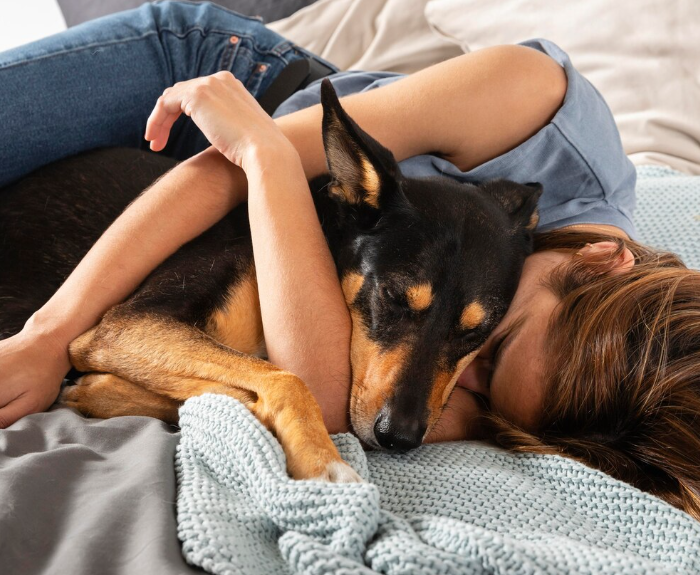2024-02-05
You are coming home after a long day at work, ready to engage in new tasks that have to be done, including feeding your furry friend, taking them for a walk and spending time bonding with them. At some point, it looks like you have already checked all the pending tasks and are ready to go to bed...but wait, no! Your dog does not think the same way, do they?
How often do you find yourself in situations where your furry friend simply refuses to go sleep and expects you to play with them all night long, eat again or otherwise seeks attention?
Just like in humans, keeping a routine, especially bedtime routine, can benefit our paw friends immensely! A healthy routine helps reduce stress and anxiety, contributes to improving the overall well-being, and increases energy levels. Also, dogs enjoy predictability! They are sensitive to changes in their environment, so sticking to a routine helps them feel more secure and comfortable.
If you set up a routine for your dog during the day, they will be more likely to have a good sleep at night, which, in turn, will help you have your time to rest too.
Planning specific times for feeding, playing, exercising, walking, training, etc., can also drastically improve your dog’s behavior. Your canine will learn when to expect these events during the day, which will prevent them from getting overly excited, seeking attention or misbehaving.
Another significant advantage for all dog owners is teaching their canines when it is time to go potty. Incidents at home are likely to decrease over time, as well as the need for urgent late-night walks for potty breaks. Having said that, it is important to avoid feeding your dog at night, as it is unhealthy and will increase the likelihood of incidents happening at home during the night.
Sticking to a routine will reduce the stress and anxiety in your dog caused by the unknown (when will you come home; when will they eat; when will you take them for a walk, etc.).

What a better way to encourage your dog to go to bed than providing them with a comfortable place to sleep? Based on their preferences, this could be comfy bedding, a warm plush blanket to sleep on, a doggy house, or an area at home where they can sleep comfortably and interrupted. Regardless of the option you choose for your dog to suit their needs the best, it should be a quiet place, which is dry, not exposed to air currents, and neither too hot, nor too cold.
Does your furry friend have their favorite toy to play with? If they do, you definitely should place it near their sleeping/private area to make it more comfortable and cozy. Add plush toys, your old clothing having your scent on, a cozy blanket, any items that will provide comfort to your paw friend and make them feel safe and cared for.
Some owners love having their dogs on the bed, while others prefer to teach them to use their own bedding. If you belong to the second type, you should definitely follow the tips above and make your dog’s sleeping area comfortable and cozy.
Also, you should teach them to go to their spot. In order to do that, you can follow several simple steps:
-Start with selecting a specific location where you want your dog to go. This could be their sleeping area, bed, mat, blanket, etc.
-Encourage your dog to go to the spot by using treats, praise, and affection to reward your dog when they go to the designated spot.
-Choose a command that you'll use consistently when you want your dog to go to their spot. Common commands include "Go to your spot," "Place," or any other word you prefer. Be consistent with the chosen command and do not change it over time once you pair it with the desired behavior.
-In the beginning, you may need to guide your dog to the chosen spot using a leash or by physically leading them. Use the command and reward them with treats and praise when they reach the spot.
-Repeat this process several times until your dog starts associating the spot with the command and with a positive experience (rewards).
-Once your canine understand the concept and starts going to their spot, you can add the command “Stay”.
-Ask your dog to stay on their spot while gradually increasing the duration before rewarding them.
-As your dog becomes more comfortable with staying on their spot, start increasing the distance between you and them before giving the command. Use the leash to guide them if necessary.
It is important to practice frequently, remain consistent and keep the training sessions short- no longer than 10 minutes.
You can place aromatherapy diffusers near your paw friend’s sleeping area and fill them with dog-safe scents for a calming effect. Lavender, Lemongrass, Vanilla, Peppermint, Chamomile and Ginger are among the preferred scents to reduce stress and make your canine relaxed.
The use of essential oils and calming scents will contribute to a more relaxed bedtime.
We have mentioned the important and often underrated role of music in our pets’ lives.
Playing classical music, reggae, soft rock or even simple calming sounds can foster a feeling relaxation in your dog and make their bedtime more pleasant.
When conducted properly, crate training and using a playpen for your paw family member can offer many benefits for them and you as an owner. If you decide to create train your dog, it is crucial to use positive reinforcement to help them develop a positive attitude towards the crate.
If you prefer an alternative to the crate, a playpen can come in handy. Playpens offer a larger space for dogs who may feel confined or anxious in a crate, allowing them more freedom while still maintaining a controlled environment.
Crates provide a safe and secure space for your dog when you're not able to supervise them. It can prevent accidents, destructive behavior, and keep them away from potential hazards.
Playpens also offer a confined area where your dog can play safely without the risk of wandering into dangerous areas or ingesting harmful substances.
Crates support housebreaking by relying on dogs’ natural instincts not to soil their sleeping area. Dogs are less likely to eliminate in their crates, encouraging them to "hold it" until they are let outside. If you combine crate training with sticking to a schedule, you can definitely make progress in potty training your pup.
Playpens can also be used for some time during the housebreaking process, allowing more space for your dog to move around while still restricting access to the entire house.
Another important advantage of crate training becomes apparent when you need to transport your dog. Dogs who are accustomed to their crates are more likely to remain calm when transported (e.g. to a veterinarian’s office) or brought on a plane.
Crates also help manage and reduce destructive behaviors (especially in puppies), anxiety, or overexcitement. They can be used as tools for timeout or as a quiet retreat when your dog needs a break.
Last, but not least, crate training aids in basic obedience training. It can also be used for teaching a dog to settle down and relax. Playpens, on the other hand, can be used to reinforce training in a more open space, enabling interactive play and positive reinforcement.
Spending quality time with your pup and bonding over pleasant activities like playing with their favorite toys will help you strengthen your bond. However, your paw friend should learn to recognize when playtime is over and bedtime is coming.
It is recommended that you avoid playing with your dog right before their bedtime, as this is likely to make them excited. Playtime and exercises should be during (mornings and afternoons) and not before bedtime.
If you give your furry friend a lot of treats or water before bedtime, they are very likely to have to go out to relieve at night. This will interrupt both their and your sleep, so you should feed your pup several hours before bed.
If your dog is still a pup, you may place pee pads in several areas at home until they are housebroken and learn to hold their bladder. Alternatively, you may need to take them for potty breaks at night.

If none of the tips listed above does not bring the desired results and your dog is still having a hard time to sleep at night, you should rule out any potential medical conditions.
Take into account any deviations from your paw friend’s standard behavior. If they start having sleeping issues out of a sudden or if there are other signs, such as lethargy, irritation, decreased appetite, you should see a veterinarian.
Check your dog’s body for any swollen parts or pain by gently tapping with your hands. Check their gums (see if they are colored differently, e.g. too pale or too red), eyes for discharge, and ears.
Another thing to keep track of is the dog’s stool- does it have normal consistency or is rather too hard / too soft; is it colored differently than usual (of course, shades vary based on the diet, but drastic changes may indicate an issue); does it have a very unpleasant and odd odor.